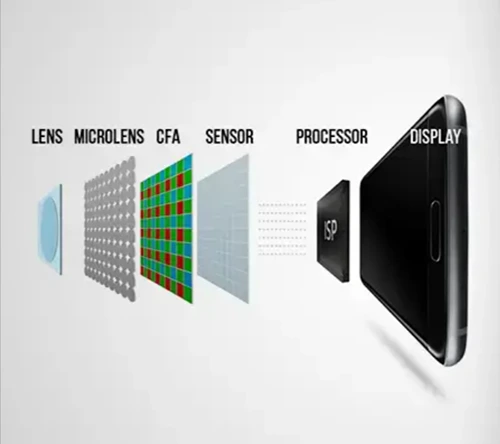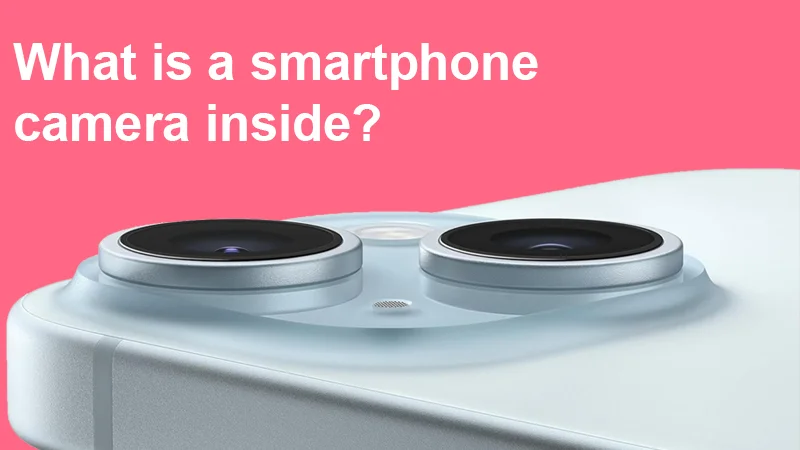The palm of our hands possesses modern smartphones that have a remarkable marvel – the camera. It captures cherished moments, transforms mundane scenes into art, and has become an indispensable feature of our daily lives. Let’s unravel the magic behind these miniature lenses and sensors that shape our photographic experiences.
Components inside the Smartphone Camera
1. The Lens:
Lens is the eye of the camera, capturing light and shaping our visual narratives. Composed of multiple plastic elements, its primary role is to focus incoming light onto the sensor. By doing so, it ensures clarity and detail in our photos.
2. The Sensor:
At the heart of the camera lies the sensor, a mosaic of millions of light-sensitive cells. When light enters through the lens, these cells generate electrical charges. This transformation from light to electric signals forms the basis of our digital images.
3. The Software:
The unsung hero behind the scenes is the software. Responsible for orchestrating the camera’s symphony, it controls vital settings like ISO, shutter speed, and white balance. These settings collectively form the exposure triangle, influencing the overall quality of the image.
Table of Smartphone Camera Components
| S.No | Component |
|---|---|
| 1 | Lens |
| 2 | Image Sensor |
| 3 | Aperture |
| 4 | Shutter |
| 5 | Image Signal Processor |
| 6 | Autofocus Mechanism |
| 7 | Optical Image Stabilization |
| 8 | Flash |
| 9 | Color Filter Array (CFA) |
| 10 | Microlens Array |
| 11 | Depth Sensor |
| 12 | Software Processing |
| 13 | Front-facing Camera |
How Phone Cameras are capable of Capturing images in varied light conditions?
While smartphone cameras have improved, dedicated cameras still outperform in low-light scenarios due to larger sensors and specialized lenses. Although smartphones excel in capturing moments under diverse lighting, they might falter in challenging low-light scenarios. Dedicated cameras still hold an edge in such conditions, but advancements continue to narrow the gap.

Exposure Triangle:
ISO (Sensitivity to Light):
ISO measures how sensitive the camera’s sensor is to light. Higher ISO values enhance sensitivity but may introduce noise. Striking the right balance ensures well-exposed images in various lighting conditions.
Shutter Speed (Duration of Exposure):
Shutter speed dictates how long the camera’s shutter remains open. A faster shutter freezes action, while a slower one captures more light, ideal for low-light settings or creative effects like motion blur.
White Balance (Color Interpretation):
White balance determines how the camera perceives colors in a scene. Adjusting this setting ensures accurate color reproduction, preventing images from appearing too warm or cool.
Crafting Smartphone Camera
- Lens Production: The lens elements are meticulously crafted by molding plastic, ensuring optimal light gathering and focus.
- Sensor Creation: The sensor, etched onto a silicon wafer, forms the core of the camera. Millions of tiny light-sensitive cells work harmoniously to capture the essence of a moment.
- Assembly and Testing: Lens and sensor come together in the camera module, subjected to rigorous testing to guarantee flawless functionality.
- Integration into Phones: Once validated, the camera module is seamlessly integrated into the smartphone, ready to embark on its visual journey.
Image Quality
Contrary to popular belief, the number of megapixels isn’t the sole determinant of image quality. Equally crucial are the size of the sensor and the quality of the lens. A high megapixel count may impress on paper, but real-world results hinge on the synergy of these components.
Reference Video
FAQ’s
How does white balance affect my photos?
White balance ensures accurate color reproduction. Adjusting it helps avoid color biases, creating more natural-looking images. Adjusting this setting ensures accurate color reproduction, preventing images from appearing too warm or cool.
What are the myths behind megapixels?
Contrary to popular belief, the number of megapixels doesn't solely determine image quality. The size of the sensor and the quality of the lens play equally crucial roles. So, when assessing a phone camera, consider the bigger picture beyond megapixels.
Bottom Up
In the final verdict, the fusion of lens, sensor, and software in smartphone cameras represents a symphony of technology. Understanding the intricacies allows us to appreciate the artistry behind the snapshots we capture daily. As technology advances, our pocket-sized lenses continue to redefine the way we perceive and immortalize the world around us.

